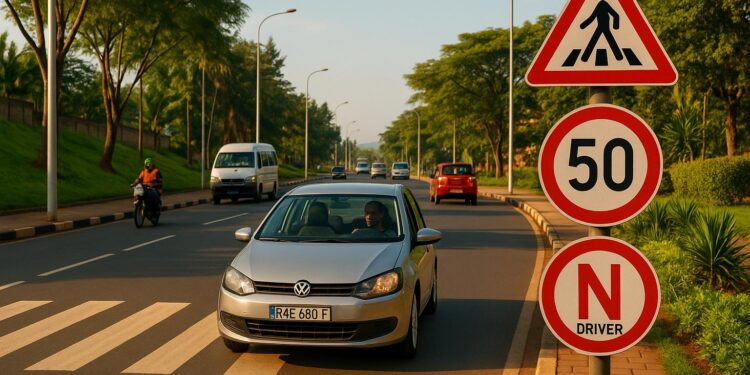Rwanda’s traffic rules prioritize safety and order, making it essential for new drivers to understand and follow them. This guide covers everything you need to know to drive legally and confidently in the country. Key points include:
- Road Signs: Learn the meanings of speed limits, stop signs, zebra crossings, and no parking zones.
- Speed Limits: Urban areas are limited to 40 km/h (25 mph), while rural roads often allow up to 60-80 km/h (37-50 mph).
- Right-Hand Driving: Always overtake on the left, yield at roundabouts, and give pedestrians priority at crossings.
- Licensing Process: Obtain your provisional and definitive licenses through the IremboGov platform.
- Traffic Violations: Fines for offenses like speeding or drunk driving are issued digitally, with payment required within three days.
- Safe Driving Tips: Adjust for hilly terrain, rainy seasons, and unpaved roads. Maintain safe distances and practice smooth braking.
Understanding these rules helps you avoid fines, stay safe, and enjoy a smooth driving experience in Rwanda.
20 Essential Road Signs Every Driver Must Know
Basic Road Traffic Rules in Rwanda
Rwanda’s traffic rules are the backbone of safe driving, ensuring smooth movement across both bustling city streets and quieter rural roads. Below, we’ll cover the essentials, including key road signs, speed limits, and driving practices every new driver should know.
Road Signs and Lane Markings
Road signs in Rwanda rely on English text or universal symbols, making them easy to understand for locals and visitors alike. Ignoring these signs can lead to a fine of 10,000 RWF (roughly $10).
Here are some critical signs and markings to keep in mind:
- Speed Limit Signs: These vary depending on location and time. School zones, urban streets, and highways all have different limits, so staying alert is crucial to avoid violations.
- Stop Signs: Always come to a complete stop at these, even if the road appears clear.
- Yield Signs: Slow down or stop to let vehicles on the main road pass before proceeding.
- Zebra Crossings: Marked with black and white stripes, these indicate pedestrian crossings. Drivers must stop and wait until the crossing is entirely clear before moving.
- No Overtaking: Found on main roads and sharp bends, these signs indicate where passing is prohibited. Solid white lines reinforce this restriction, while dashed lines show where overtaking is allowed.
- No Parking: These signs are strictly enforced. In restricted areas, you can stop briefly (under 5 minutes) to drop off or pick up passengers. Exceeding this limit could result in fines or your vehicle being towed.
- Construction Zones: Brightly colored "Men at Work" signs warn of roadwork ahead. Drivers should reduce speed and exercise extra caution in these areas.
- Emergency Vehicle Zones: Parking near entrances or exits for emergency vehicles is prohibited to keep access clear.
Speed Limits in Different Areas
Speed limits in Rwanda depend on the type of road and surrounding environment. Here’s a breakdown:
- Urban Areas: In cities, towns, and other built-up areas, the speed limit is typically 40 km/h (25 mph). Near schools or in areas with heavy pedestrian traffic, limits may be even lower.
- Rural Roads: The standard speed limit is 60 km/h (37 mph), though some roads allow speeds up to 80 km/h (50 mph), depending on conditions and local regulations.
Speed limits can also change based on the time of day, such as during school hours, so always pay close attention to posted signs.
Right-Hand Driving Rules
Rwanda follows right-hand driving, which influences how you handle intersections, overtaking, and merging.
- Overtaking: Always overtake on the left. Passing on the right is not allowed.
- Roundabouts: Vehicles already in the roundabout have the right-of-way. If you’re approaching, yield to circulating traffic and use your signal when exiting to indicate your intentions.
- Pedestrian Crossings: Pedestrians have priority at zebra crossings and other designated areas. Stop when someone is waiting to cross, even if they haven’t stepped into the crosswalk yet.
- Yield Signs at Intersections: Slow down or stop to let vehicles on the main road pass before proceeding. Make sure the intersection is completely clear before merging or continuing.
While many Rwandan drivers practice defensive driving, newcomers should be especially cautious when navigating roundabouts or merging into traffic. Familiarity with these right-hand driving rules will help you adapt to Rwanda’s traffic flow with confidence.
How to Get a Driver’s License in Rwanda
Getting a driver’s license in Rwanda involves a two-step process primarily handled online through IremboGov. First, you’ll need to secure an e-Provisional License. Once you pass the final driving test, you can apply for your definitive license.
Requirements and Documents Needed
To pass the written test, you’ll need a minimum score of 60% at the Busanza Automated Test Center or at least 12 out of 20 at other exam centers. The test includes questions on traffic rules, road signs, and safe driving practices.
Here’s what you’ll need to apply:
- A valid national ID that matches your test registration
- An active phone number and email address
- The registration code from your exam registration
If you’re renewing a license, you’ll also need:
- Your expired license
- The original copy of your provisional license
- The provisional driving license code
License Application Steps
Once you’ve gathered the necessary documents, the application process is straightforward. Start by applying for your e-Provisional License. If you’ve passed your test, visit www.irembo.gov.rw or dial *909#. Log into your Irembo account or create one if you’re new to the platform.
From the "Police" section, select "Application for Driving License" and then choose "Application for Provisional Driving License". Enter the registration code you received during exam registration. The system will display your test scores and personal details for verification.
After confirming your information and entering your contact details, submit the application. Once payment is complete, your e-Provisional License will be available for download from your IremboGov profile or sent to your email.
For the definitive license, you’ll need to pass the final driving test. Use your e-Provisional License to register for driving school and schedule the test. After passing, revisit IremboGov, select "Application for Definitive Driving License", and provide your registration code, preferred collection district, and pickup station.
License Renewal and Point System
Provisional licenses are valid for one year, while definitive licenses have a longer validity period. Renewals are processed online through IremboGov, with a standard fee of 5,000 RWF (about $5.00) for both provisional and definitive licenses.
For provisional license renewals, you’ll need to submit the physical copy of your provisional license at your chosen pickup station after completing the online payment. Definitive license renewals require you to pick up your new license at your selected police station once notified.
Rwanda also employs a penalty points system to encourage safe driving. Accumulating too many points can result in license suspension or revocation. Keeping a clean driving record is essential for avoiding penalties and ensuring smooth renewals.
Although digital confirmation is instant, physical processing takes up to 21 days. It’s a good idea to plan ahead to avoid driving with an expired license, which can lead to fines or complications during traffic stops. Staying on top of renewals not only keeps you compliant but also supports safer driving practices across Rwanda.
sbb-itb-7bc66b5
Traffic Violations and Fines
After familiarizing yourself with traffic rules and licensing procedures, it’s equally important to understand the consequences of breaking those rules. Traffic violations come with fines and penalties that can affect your driving record and encourage safer behavior on the road.
Common Traffic Violations and Fines
The Rwanda National Police handles traffic violations through two main types of notices. Electronic tickets are issued directly by traffic officers using mobile devices and sent to your phone number. Camera-detected tickets, on the other hand, are issued for specific offenses like speeding or running red lights. These tickets are automatically generated, and the vehicle owner receives a notification via SMS based on registration details.
For camera-detected violations, the SMS includes important details such as the date, time, location, posted speed limit, recorded speed (if it’s a speeding offense), and the fine amount.
Fines must be paid within three days. Failure to pay on time results in an automatic late fee of RWF 10,000 (approximately $10.00). The exact fine amount varies depending on the type of violation.
Drunk Driving Laws
Rwanda has a zero-tolerance policy when it comes to driving under the influence. This strict approach aims to ensure road safety for all.
Traffic Cameras and Digital Monitoring
Rwanda’s traffic enforcement relies heavily on digital monitoring systems that work 24/7. Automated cameras are strategically placed to catch speeding and red light violations. These systems eliminate the need for officer intervention, as tickets are sent directly to the vehicle owner via SMS shortly after the offense occurs. The system uses your license plate and registration data to generate and deliver the notification.
Paying fines is straightforward and fully digital. You can use the IremboGov web platform at www.irembo.gov.rw or dial *909# to process payments. When paying online, you’ll need your license plate number and either the TIN (from your vehicle’s logbook or carte jaune) or the specific ticket number. Keep in mind that billing numbers for online payments expire within one hour, so it’s important to act quickly.
This automated system showcases Rwanda’s dedication to efficient and consistent traffic enforcement. With continuous monitoring of key intersections and highways, the system encourages safer driving habits across the country.
In April 2025, Rwanda’s Cabinet approved a draft law to introduce a merit/demerit point system for drivers. This system will assign or deduct points based on driving behavior, reflecting the country’s efforts to improve traffic management. It highlights the importance of following traffic laws and ties into the safe driving practices discussed later.
Safe Driving Tips for Rwanda Roads
Rwanda’s strict traffic rules set the stage for safer roads, but knowing how to handle the country’s unique driving conditions is just as important. These tips will help new drivers navigate with confidence and care.
Handling Rwanda’s Road Conditions
Rwanda’s hilly landscape presents distinct driving challenges. With steep inclines, winding roads, and unpredictable weather, staying alert is key.
For driving uphill, shift to a lower gear early to keep your engine running smoothly and avoid strain. This not only helps your car climb efficiently but also protects your transmission. When heading downhill, rely on engine braking by downshifting instead of constantly pressing the brake pedal. This prevents overheating and keeps your brakes effective during long descents.
The rainy seasons (March-May and October-December) call for extra caution. Wet roads increase stopping distances, so maintain at least a four-second gap from the car ahead. Slow down gradually to prevent skidding, and when driving through standing water, aim for the center of the road where it’s usually shallowest.
Rural roads often lack proper lighting and may be unpaved. At night, use high beams for better visibility when there’s no oncoming traffic, but switch to low beams as soon as another vehicle approaches. Keep your windshield and headlights clean, especially in dusty conditions, to ensure clear vision.
By staying mindful of these challenges, you can better prepare for Rwanda’s diverse road conditions.
Safe Driving Techniques
Practicing defensive driving is one of the best ways to stay safe on the road. Always anticipate that other drivers might make mistakes and position yourself to avoid potential hazards. Scan the road ahead and check your mirrors every 5-8 seconds to stay aware of your surroundings.
Use the three-second rule to maintain a safe following distance. Pick a fixed point on the road, and when the car ahead passes it, count "one-thousand-one, one-thousand-two, one-thousand-three." If you reach the point before finishing the count, you’re too close. In rainy or poor visibility conditions, increase this to four or five seconds.
At intersections, exercise extra caution. Even if you have the right-of-way, look both ways before proceeding. Always come to a full stop at stop signs, and avoid rushing through yellow lights. If you’re already in the intersection when the light changes, keep going rather than stopping abruptly.
When changing lanes, signal early and check your blind spots by turning your head to look over your shoulder. Mirrors alone don’t provide a full view. Make lane changes gradually, and avoid cutting off other drivers, as this can lead to accidents or road rage.
In emergency situations, staying calm is critical. If your brakes fail, pump the pedal quickly and engage the parking brake gently. Steer toward a safe area without sudden movements. For a tire blowout, grip the steering wheel firmly, avoid slamming on the brakes, and let your vehicle slow naturally while steering to safety.
Combining these techniques with adherence to Rwanda’s traffic laws creates a safer driving environment for everyone.
Fuel-Efficient Driving Methods
Safe driving doesn’t just protect you – it can also save money. Efficient driving can cut fuel consumption by up to 20%, which helps both your wallet and the environment.
Smooth acceleration and braking are key. Avoid sudden starts and stops, and use cruise control on highways to maintain a steady speed. When approaching red lights or slow traffic, ease off the accelerator early and coast to a stop instead of braking abruptly.
Speed management plays a big role in fuel economy. Most cars are most efficient between 45-55 mph (72-88 km/h). Driving at 70 mph (113 km/h) can use about 15% more fuel than driving at 55 mph (88 km/h).
Regular vehicle maintenance is another simple way to save fuel. Keep your tires properly inflated to the manufacturer’s recommendations – underinflated tires can lower fuel efficiency by up to 3%. Routine oil changes, clean air filters, and well-aligned wheels also improve mileage.
Plan your trips to avoid unnecessary fuel use. Combine errands into one trip, and steer clear of peak traffic times to reduce stop-and-go driving. Remove heavy items from your car, as every extra 100 pounds can decrease fuel efficiency by 1-2%. At highway speeds, keep your windows closed and use the air conditioning instead, as open windows increase drag.
Finally, practice smart engine management. Turn off your engine if you’re stopped for more than 30 seconds, like at railway crossings or construction zones. Modern engines don’t need long warm-up periods, so start driving gently within 30 seconds of starting the car.
Summary: What New Drivers Should Remember
Starting your driving journey in Rwanda means embracing the traffic laws designed to keep everyone safe. Here’s a quick recap of the key rules and practices you need to know.
Pay attention to speed limits – lower limits apply in urban areas, while highways allow for higher speeds. Rwanda follows right-hand driving, and there are specific guidelines for overtaking and navigating roundabouts, so make sure you’re familiar with them.
Your driver’s license is your ticket to driving legally. Keep it up to date and understand the points system – too many violations could result in suspension. Beyond having a valid license, good daily driving habits are critical to avoiding fines and penalties.
Speaking of penalties, traffic violations come with real financial consequences. Fines must be paid within three days to avoid further charges, so it’s wise to drive carefully and stay compliant.
Defensive driving is key to safely handling Rwanda’s diverse terrain. Always maintain safe following distances, especially in bad weather. On downhill stretches, use engine braking to reduce wear on your brakes. Stay alert and keep an eye out for potential hazards ahead.
Don’t overlook regular vehicle maintenance – it’s essential for both safety and fuel efficiency. Check your tire pressure, change the oil on time, and keep air filters clean. These small steps can prevent breakdowns and ensure your vehicle performs well, especially on hilly roads.
Lastly, patience, courtesy, and clear signaling go a long way in ensuring safe and smooth road sharing across Rwanda.
FAQs
How can I get a driver’s license in Rwanda, and what is the process for applying through IremboGov?
To obtain a driver’s license in Rwanda, the process begins with passing the practical driving test. Once you’ve successfully passed, you can move forward by applying for your definitive license online through the IremboGov platform.
Here’s how to apply:
- Visit the IremboGov website and select the Application for Definitive Driving License service.
- Enter your registration code and choose your preferred collection district and pickup station.
- Provide your phone number or email address for communication.
- Verify all your details, then submit the application.
- Use the generated billing ID to complete your payment.
After your application is processed, you’ll receive a notification letting you know when and where to pick up your license.
What is Rwanda’s penalty points system, and what happens if you accumulate too many points?
Rwanda’s penalty points system aims to encourage safer driving habits by tracking traffic violations. When a driver commits an offense, points are added to their record based on the seriousness of the violation.
Accruing too many points within a set timeframe can lead to significant consequences. These may include fines, license suspension, or even mandatory driving courses. Staying mindful of traffic laws and practicing responsible driving is key to avoiding these penalties.
What are some essential tips for driving safely on Rwanda’s hilly roads and in unpredictable weather?
Driving through Rwanda’s hilly landscapes and unpredictable weather can be challenging, but with some extra care, you can ensure a safer journey. Here’s how to navigate these conditions effectively:
- Control your speed and use lower gears: On steep inclines or descents, keep your speed steady and shift to lower gears. This helps maintain control and reduces wear on your brakes.
- Drive cautiously in rain or fog: Wet roads and poor visibility can make driving tricky. Slow down, turn on your headlights, and leave plenty of space between your vehicle and others.
- Brake smoothly on slopes: Sudden braking on steep roads can lead to skidding. Instead, apply brakes gently and rely on engine braking to manage your speed.
- Watch out for pedestrians and cyclists: Many roads, especially in rural or hilly areas, are shared with pedestrians and cyclists. Stay alert and give them ample room.
With these precautions, you’ll be better prepared to tackle Rwanda’s unique road conditions safely and with confidence.
Related Blog Posts
- 10 Tips for Long Drives in Rwanda
- 10 Common Road Signs in Rwanda
- Ultimate Guide to Off-Road Driving in Rwanda
- Updated Rwanda Road Traffic Regulations 2025





